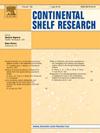Shear instabilities in Internal Solitary Waves under high and low-wind regimes
IF 2.2
3区 地球科学
Q2 OCEANOGRAPHY
引用次数: 0
Abstract
Wind and Internal Solitary Waves (ISWs) are well-known to mix the ocean's surface and inner stratification, but their combined effects appear to have not yet been investigated. A large ensemble of ISWs measured off the Portuguese Coast reveals that wind and ISWs may combine to increase turbulence and mixing beyond the linear combination of their individual contributions. It is found that low bulk Richardson numbers () and temperature inversions increase respectively by nearly four-fold and an order of magnitude, when comparing ISWs propagating under high and low-wind regimes. Furthermore, depth ranges where associated with ISWs propagating with high winds are observed to extend at least between unperturbed thermocline and intermediate depths. Understanding how turbulence and mixing from ISWs and wind combine may have important implications ranging from parametrizations in ocean models to our understanding of biogeochemical processes modulated by diapycnal mixing.
高、低风条件下内孤立波的剪切不稳定性
众所周知,风和内孤立波(ISWs)可以混合海洋表面和内部分层,但它们的综合效应似乎尚未被研究。在葡萄牙海岸测量的大型isw集合表明,风和isw可能联合起来增加湍流和混合,超出了它们各自贡献的线性组合。研究发现,当比较在高风和低风条件下传播的isw时,低体积理查德森数(Ri<14)和逆温分别增加了近四倍和一个数量级。此外,观测到与isw伴随大风传播相关的Ri<;14的深度范围至少在未扰动的温跃层和中间深度之间延伸。了解来自isw和风的湍流和混合如何结合可能具有重要的意义,从海洋模式的参数化到我们对由双周期混合调节的生物地球化学过程的理解。
本文章由计算机程序翻译,如有差异,请以英文原文为准。
求助全文
约1分钟内获得全文
求助全文
来源期刊

Continental Shelf Research
地学-海洋学
CiteScore
4.30
自引率
4.30%
发文量
136
审稿时长
6.1 months
期刊介绍:
Continental Shelf Research publishes articles dealing with the biological, chemical, geological and physical oceanography of the shallow marine environment, from coastal and estuarine waters out to the shelf break. The continental shelf is a critical environment within the land-ocean continuum, and many processes, functions and problems in the continental shelf are driven by terrestrial inputs transported through the rivers and estuaries to the coastal and continental shelf areas. Manuscripts that deal with these topics must make a clear link to the continental shelf. Examples of research areas include:
Physical sedimentology and geomorphology
Geochemistry of the coastal ocean (inorganic and organic)
Marine environment and anthropogenic effects
Interaction of physical dynamics with natural and manmade shoreline features
Benthic, phytoplankton and zooplankton ecology
Coastal water and sediment quality, and ecosystem health
Benthic-pelagic coupling (physical and biogeochemical)
Interactions between physical dynamics (waves, currents, mixing, etc.) and biogeochemical cycles
Estuarine, coastal and shelf sea modelling and process studies.
 求助内容:
求助内容: 应助结果提醒方式:
应助结果提醒方式:


